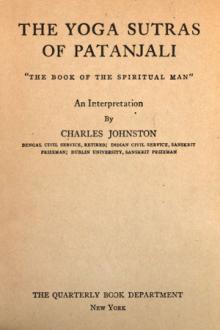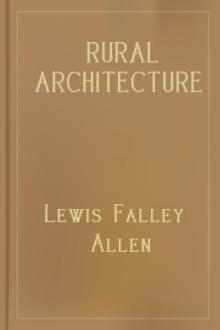An Introduction to Yoga, Annie Besant [good books to read for 12 year olds .txt] 📗

- Author: Annie Besant
- Performer: 8170590507
Book online «An Introduction to Yoga, Annie Besant [good books to read for 12 year olds .txt] 📗». Author Annie Besant
rhythm, and it becomes cognition in Prakriti. The quality that we call life in Purusha is taken up by, or reflected, in the guna called Rajas—mobility, and it becomes force, energy, activity, in Prakriti. The quality that we call immutability in Purusha is taken up by, or reflected, in the guna called Tamas—inertia, and shows itself out as will or desire in Prakriti. So that, in that balanced equilibrium of Prakriti, a change has taken place by the mere propinquity of, or presence of, the Purusha. The Purusha has lost nothing, but at the same time a change has taken place in matter. Cognition has appeared in it. Activity, force, has appeared in it. Will or desire has appeared in it. With this change in Prakriti another change occurs. The three attributes of Purusha cannot be separated from each other, nor can the three attributes of Prakriti be separated each from each. Hence rhythm, while appropriating awareness, is under the influence of the whole three-in-one Purusha and cannot but also take up subordinately life and immutability as activity and will. And so with mobility and inertia. In combinations one quality or another may predominate, and we may have combinations which show preponderantly awareness-rhythm, or life-mobility, or immutability-inertia. The combinations in which awareness-rhythm or cognition predominates become “mind in nature,” the subject or subjective half of nature. Combinations in which either of the other two predominates become the object or objective half of nature, the ” force and matter ” of the western scientist.[FN#7: A friend notes that the first is the Suddha Sattva of the Ramanuja School, and the second and third the Prakriti, or spirit-matter, in the lower sense of the same.]
We have thus nature divided into two, the subject and the object.
We have now in nature everything that is wanted for the manifestation of activity, for the production of forms and for the expression of consciousness. We have mind, and we have force and matter. Purusha has nothing more to do, for he has infused all powers into Prakriti and sits apart, contemplating their interplay, himself remaining unchanged. The drama of existence is played out within Matter, and all that Spirit does is to look at it. Purusha is the spectator before whom the drama is played. He is not the actor, but only a spectator. The actor is the subjective part of nature, the mind, which is the reflection of awareness in rhythmic matter. That with which it works—objective nature, is the reflection of the other qualities of Purusha—life and immutability—in the gunas, Rajas and Tamas. Thus we have in nature everything that is wanted for the production of the universe. The Putusha only looks on when the drama is played before him. He is spectator, not actor. This is the predominant note of the Bhagavad-Gita. Nature does everything. The gunas bring about the universe. The man who says: “I act,” is mistaken and confused; the gunas act, not he. He is only the spectator and looks on. Most of the Gita teaching is built upon this conception of the Samkhya, and unless that is clear in our minds we can never discriminate the meaning under the phrases of a particular philosophy.
Let us now turn to the Vedantic idea. According to the Vedantic view the Self is one, omnipresent, all-permeating, the one reality. Nothing exists except the Self—that is the starting-point in Vedanta. All permeating, all-controlling, all-inspiring, the Self is everywhere present. As the ether permeates all matter, so does the One Self permeate, restrain, support, vivify all. It is written in the Gita that as the air goes everywhere, so is the Self everywhere in the infinite diversity of objects. As we try to follow the outline of Vedantic thought, as we try to grasp this idea of the one universal Self, who is existence, consciousness, bliss, Sat-Chit-Ananda, we find that we are carried into a loftier region of philosophy than that occupied by the Samkhya. The Self is One. The Self is everywhere conscious, the Self is everywhere existent, the Self is everywhere blissful. There is no division between these qualities of the Self. Everywhere, all-embracing, these qualities are found at every point, in every place. There is no spot on which you can put your finger and say “The Self is not here.” Where the Self is—and He is everywhere—there is existence, there is consciousness, and there is bliss. The Self, being consciousness, imagines limitation, division. From that imagination of limitation arises form, diversity, manyness. From that thought of the Self, from that thought of limitation, all diversity of the many is born. Matter is the limitation imposed upon the Self by His own will to limit Himself. “Eko’ham, bahu syam,” “I am one; I will to he many”; “let me be many,” is the thought of the One; and in that thought, the manifold universe comes into existence.
In that limitation, Self-created, He exists, He is conscious, He is happy. In Him arises the thought that He is Self-existence, and behold! all existence becomes possible. Because in Him is the will to manifest, all manifestation at once comes into existence.
Because in Him is all bliss, therefore is the law of life the seeking for happiness, the essential characteristic of every sentient creature. The universe appears by the Self-limitation in thought of the Self. The moment the Self ceases to think it, the universe is not, it vanishes as a dream. That is the fundamental idea of the Vedanta. Then it accepts the spirits of the Samkhya—
the Purushas; but it says that these spirits are only reflections of the one Self, emanated by the activity of the Self and that they all reproduce Him in miniature, with the limitations which the universal Self has imposed upon them, which are apparently portions of the universe, but are really identical with Him. It is the play of the Supreme Self that makes the limitations, and thus reproduces within limitations the qualities of the Self; the consciousness of the Self, of the Supreme Self; becomes, in the particularised Self, cognition, the power to know; and the existence of the Self becomes activity, the power to manifest; and the bliss of the Self becomes will, the deepest part of all, the longing for happiness, for bliss; the resolve to obtain it is what we call will. And so in the limited, the power to know, and the power to act, and the power to will, these are the reflections in the particular Self of the essential qualities of the universal Self. Otherwise put: that which was universal awareness becomes now cognition in the separated Self; that which in the universal Self was awareness of itself becomes in the limited Self awareness of others; the awareness of the whole becomes the cognition of the individual. So with the existence of the Self: the Self-existence of the universal Self becomes, in the limited Self, activity, preservation of existence. So does the bliss of the universal Self, in the limited expression of the individual Self, become the will that seeks for happiness, the Self-determination of the Self, the seeking for Self-realisation, that deepest essence of human life.
The difference comes with limitation, with the narrowing of the universal qualities into the specific qualities of the limited Self; both are the same in essence, though seeming different in manifestation. We have the power to know, the power to will, and the power to act. These are the three great powers of the Self that show themselves in the separated Self in every diversity of forms, from the minutes” organism to the loftiest Logos.
Then just as in the Samkhya, if the Purusha, the particular Self, should identify himself with the matter in which he is reflected, then there is delusion and bondage, so in the Vedanta, if the Self, eternally free, imagines himself to be bound by matter, identifying himself with his limitations, he is deluded, he is under the domain of Maya; for Maya is the self-identification of the Self with his limitations. The eternally free can never be bound by matter; the eternally pure can never be tainted by matter; the eternally knowing can never be deluded by matter; the eternally Self-determined can never be ruled by matter, save by his own ignorance. His own foolish fancy limits his inherent powers; he is bound, because he imagines himself bound; he is impure, because he imagines himself impure; he is ignorant, because he imagines himself ignorant. With the vanishing of delusion he finds that he is eternally pure, eternally wise.
Here is the great difference between the Samkhya and the Vedanta.
According to the Samkhya, Purusha is the spectator and never the actor. According to Vedanta the Self is the only actor, all else is maya: there is no one else who acts but the Self, according to the Vedanta teaching. As says the Upanishad: the Self willed to see, and there were eyes; the Self willed to hear, and there were ears; the Self willed to think, and there was mind. The eyes, the ears, the mind exist, because the Self has willed them into existence. The Self appropriates matter, in order that He may manifest His powers through it. There is the distinction between the Samkhya and the Vedanta: in the Samkhya the propinquity of the Purusha brings out in matter or Prakriti all these characteristics, the Prakriti acts and not the Purusha; in the Vedanta, Self alone exists and Self alone acts; He imagines limitation and matter appears; He appropriates that matter in order that He may manifest His own capacity.
The Samkhya is the view of the universe of the scientist: the Vedanta is the view of the universe of the metaphysician. Haeckel unconsciously expounded the Samkhyan philosophy almost perfectly.
So close to the Samkhyan is his exposition, that another idea would make it purely Samkhyan; he has not yet supplied that propinquity of consciousness which the Samkhya postulates in its ultimate duality. He has Force and Matter, he has Mind in Matter, but he has no Purusha. His last book, criticised by Sir Oliver Lodge, is thoroughly intelligible from the Hindu standpoint as an almost accurate representation of Samkhyan philosophy. It is the view of the scientist, indifferent to the “why” of the facts which he records. The Vedanta, as I said, is the view of the metaphysician he seeks the unity in which all diversities are rooted and into which they are resolved.
Now, what light does Theosophy throw on both these systems?
Theosophy enables every thinker to reconcile the partial statements which are apparently so contradictory. Theosophy, with the Vedanta, proclaims the universal Self. All that the Vedanta says of the universal Self and the Self-limitation, Theosophy repeats. We call these Self-limited selves Monads, and we say, as the Vedantin says, that these Monads reproduce the nature of the universal Self whose portions they are. And hence you find in them the three qualities which you find in the Supreme. They are units’ and these represent the Purushas of the Samkhya; but with a very great difference, for they are not passive watchers, but active agents in the drama of the universe, although, being above the fivefold universe, they are as spectators who pull the strings of the players of the stage. The Monad takes to himself from the universe of matter atoms which show out the qualities corresponding to his three qualities, and in these he thinks, and wills and acts. He takes to himself rhythmic combinations, and shows his quality of cognition. He takes to himself combinations that are mobile; through those he shows out his activity.





Comments (0)